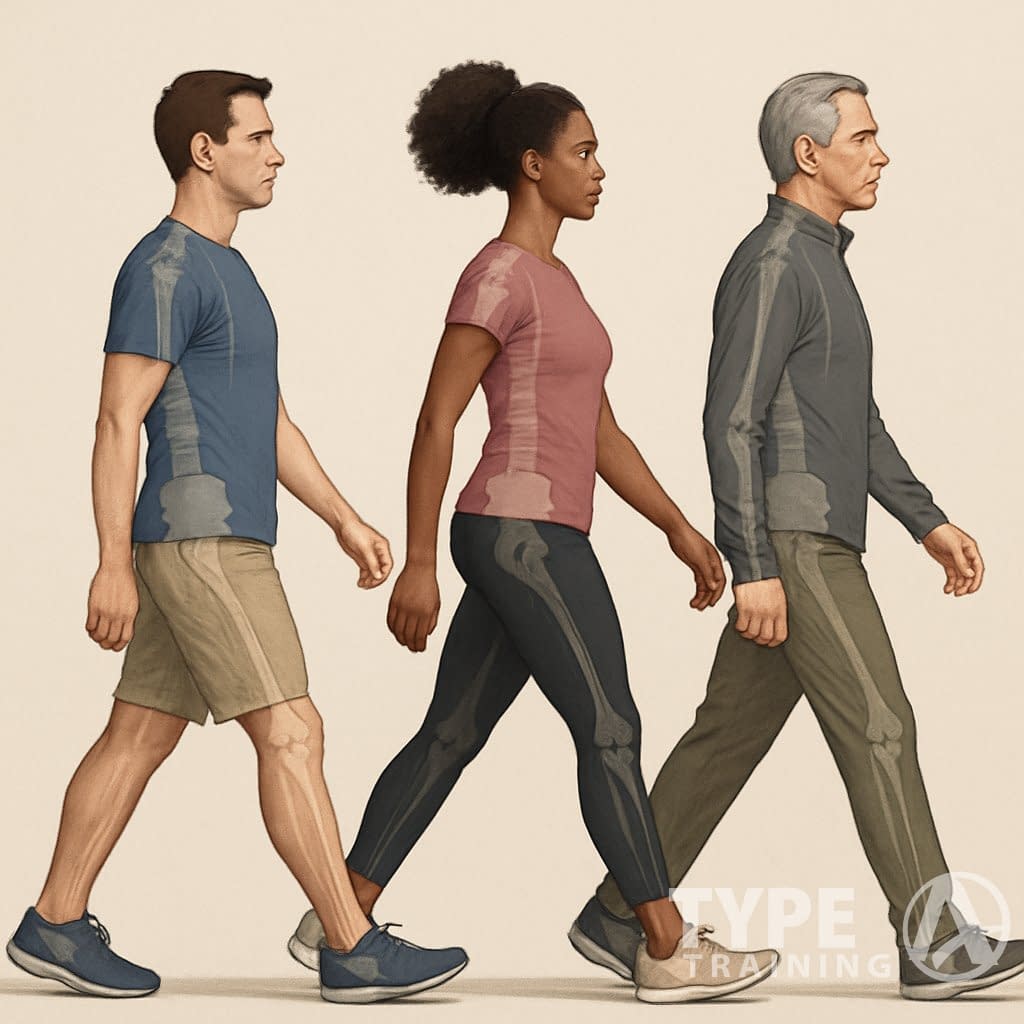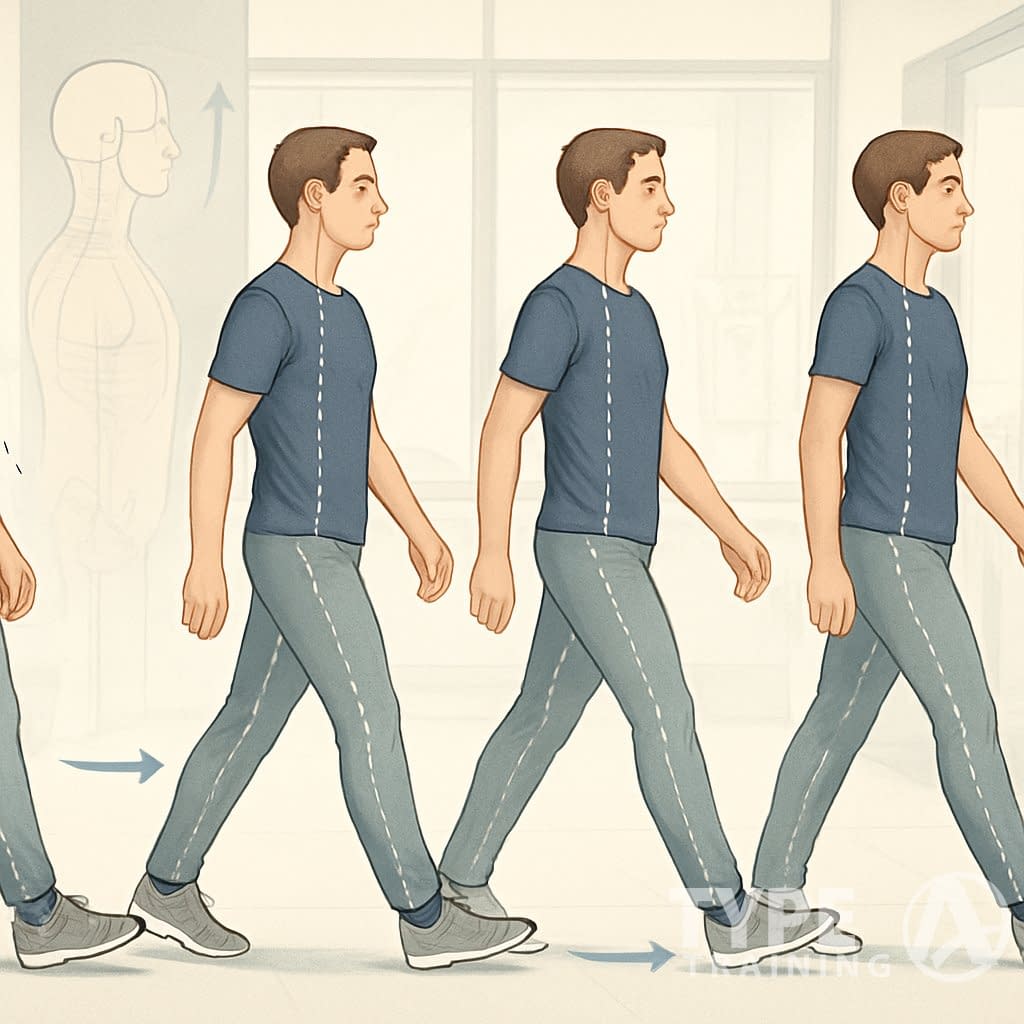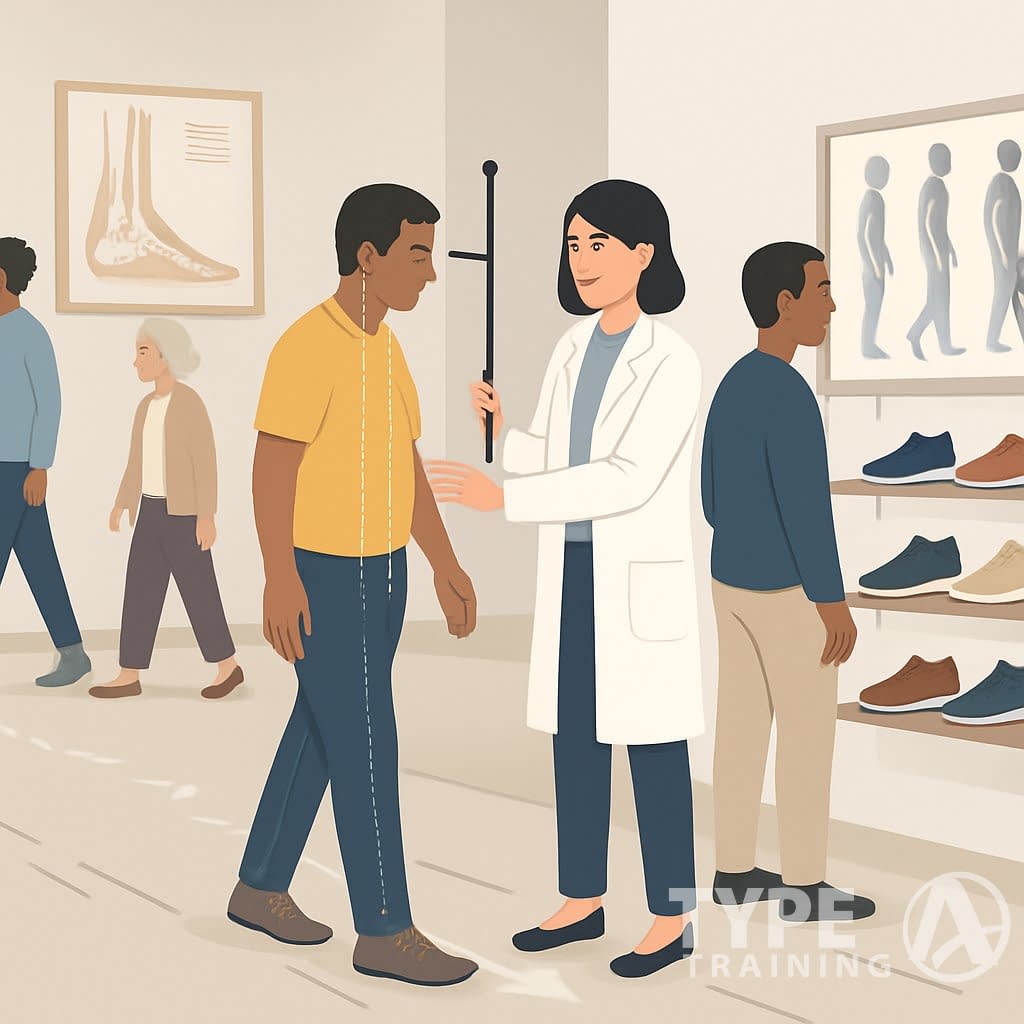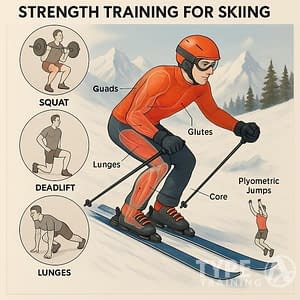Walking with good posture isn’t just about looking confident—it’s crucial for preventing pain and actually enjoying movement. Staying aligned as you walk can ease discomfort and stop new aches from popping up in your back, hips, and knees.
When you move with proper form, your body acts as a team. Weight and impact spread out more evenly across your joints.
Walking posture plays a vital role in overall health and well-being, enhancing your performance during any activity.

Popular posts:
A lot of us pick up weird walking habits without even noticing. Maybe you hunch forward, stare at your phone, or lean more on one side.
Practicing good walking posture can help reduce the risk of injuries and improve your overall mobility.
These little misalignments add up after thousands of steps, leading to chronic pain and discomfort.
The upside? A few small tweaks can turn your walking into a pain-free experience.
Key Takeaways
-
- Good walking alignment makes a straight line from your ears to your shoulders, hips, and ankles. This takes pressure off your joints and muscles.
- Standing tall with your head up and looking forward not only helps you walk better, it can even make you look slimmer.
- Practicing correct walking spreads your weight out evenly, making back, hip, and knee pain less likely.
By understanding the significance of walking posture, you can achieve a healthier lifestyle.
Understanding Walking Posture and Its Importance
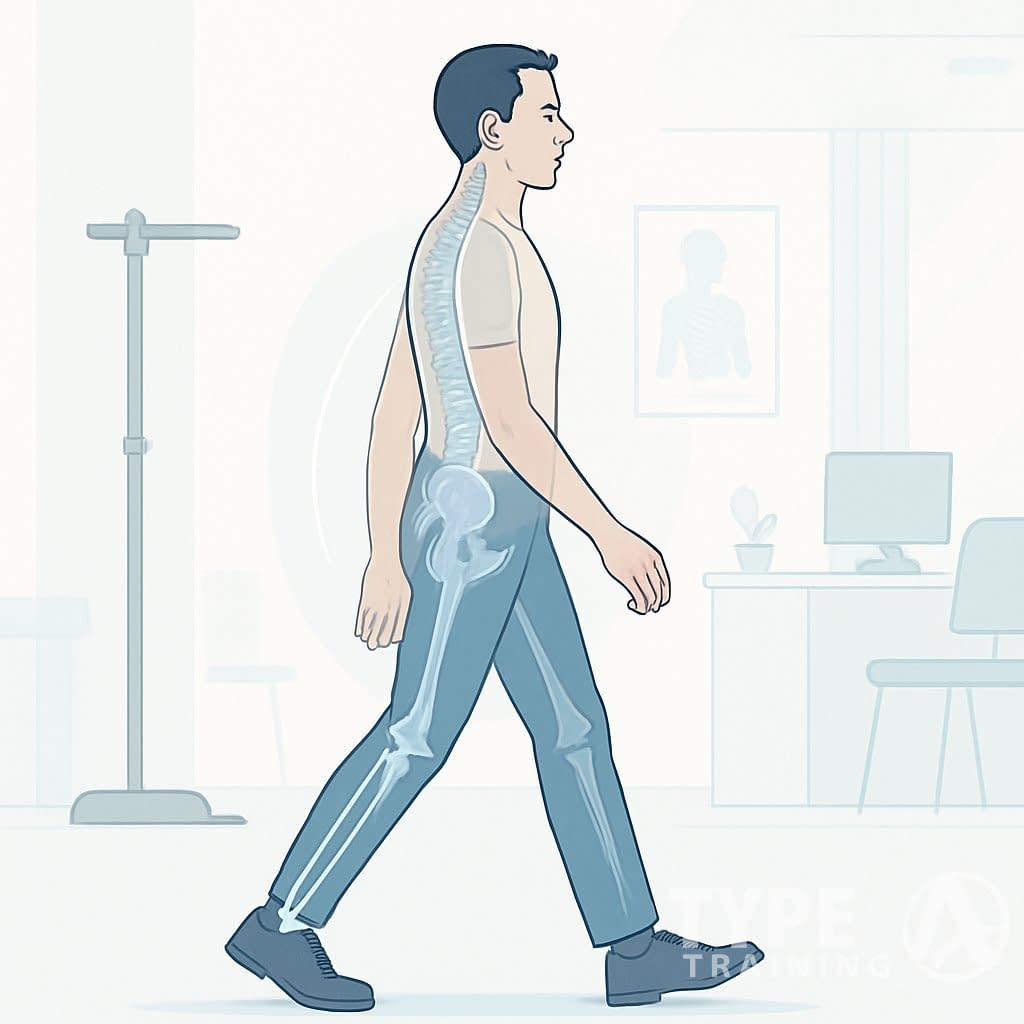
Maintaining walking posture is essential for physical fitness and long-term mobility.
Walking posture influences every step you take. It can mean the difference between pain and comfort.
Improving your walking posture can alleviate discomfort and enhance your daily activities.
Proper body alignment eases the strain on your joints and muscles. It also helps you move more efficiently.
Defining Proper Walking Alignment
Start by standing tall, letting your spine keep its natural curves. Keep your head balanced over your shoulders, not poking out in front.
Let your shoulders relax and pull them back just a bit. Engage your core muscles—they help support your lower back.
Let your arms swing at your sides, elbows slightly bent. Aim for a heel-to-toe foot strike as you walk.
Focus on your walking posture during exercises to maximize their effectiveness.
Good walking posture means:
-
- Chin level with the ground
- Shoulders relaxed, not scrunched up
- Core muscles gently braced
Good walking posture helps maintain balance and coordination, which are crucial for overall fitness.
- Eyes looking forward, maybe 20 feet ahead
- Arms swinging naturally, opposite your legs
This setup spreads your weight out and makes movement feel easier.
Consequences of Poor Posture
Bad walking habits can set off a chain reaction of physical issues. If you slouch or lean forward, you load extra stress onto your spine and muscles.
Common problems include:
Adopting a mindful approach to walking posture can prevent discomfort during physical activities.
- Neck and shoulder tension from jutting your head forward
- Lower back pain from uneven weight
- Less lung capacity if your chest is compressed
- Fatigue because muscles are working overtime
- Joint wear—especially in your knees and hips
Walking with poor posture can make pain worse and even cause new problems. Your body tries to compensate by overusing certain muscles, which leads to injuries and discomfort.
Understanding the importance of walking posture can empower you to make healthier choices.
Impact on Long-Term Mobility
How you walk now will affect how you move years from today. Proper walking posture supports healthy aging and keeps your joints and muscles balanced.
Over time, good habits help you:
Investing in proper footwear can greatly impact your walking posture and overall comfort.
- Keep your spine healthy and flexible
- Maintain muscle balance
- Reduce wear on your joints
- Improve balance and coordination
- Lower your risk of falls and injuries
Proper alignment keeps nerve pathways clear. When your body moves as it should, nerves don’t get pinched or irritated.
Research shows that good posture can even lift your mood and energy. Standing tall might send confidence signals to your brain, making physical activity feel better.
Key Elements of Optimal Walking Posture
Incorporating walking posture improvements into your routine can lead to lasting benefits.
The right walking posture lays the groundwork for pain-free, efficient movement. Body alignment affects everything from how much energy you use to your risk of injury.
Head and Neck Position
Keep your head stacked over your shoulders, chin level. Imagine a string pulling the top of your head up—this helps you stay tall.
Maintaining correct walking posture contributes to a more efficient movement pattern.
Try not to push your chin out or stare at your feet. Look ahead, maybe 15-20 feet in front. That keeps your neck aligned and eases upper back strain.
Focus on your walking posture to reduce strain on your neck and shoulders.
When your head’s in the right spot, your neck muscles work less. That means fewer tension headaches and less neck pain, especially if you walk a lot.
Shoulder and Arm Alignment
Let your shoulders relax and drop back. Don’t let them creep up toward your ears.
Bend your elbows about 90 degrees and let your arms swing forward and back—not across your body. This balances your movement and keeps you steady.
Proper arm swing helps you move forward and saves energy. Keep your hands loose, not clenched, so tension doesn’t travel up your arms to your neck.
Core and Torso Engagement
Lightly engaging your core during walking can enhance your walking posture.
Lightly engage your core muscles to support your spine. Think about gently pulling your belly button in, but don’t hold your breath.
Stand upright with a natural curve in your lower back. Skip the arching or leaning forward from your waist.
A strong core keeps your walking form solid and takes pressure off your back. It also helps you keep that heel-to-toe stride.
With each step, land softly on your heel, roll through your foot, and push off with your toes. This pattern, backed by good core posture, spreads impact evenly and protects your joints.
Step-by-Step Walking Technique for Pain-Free Movement
Regularly practicing walking posture can lead to significant health improvements.
Walking with proper technique can really take the load off your joints. Good alignment spreads your weight out and keeps pain at bay.
Initiating Each Step
Start with solid posture. Stand tall and look ahead, not down.
Let your shoulders relax and gently pull them back. Hunched shoulders can mess up your whole walking pattern.
Engage your core. Lightly tighten your abs to support your back, but don’t get stiff or hold your breath.
Swing your arms from your shoulders, not just your elbows. Move them forward and back, not across your chest. This balances your steps.
Foot Placement and Heel-to-Toe Motion
Land on your heel first. This gets the heel-to-toe pattern going and lets your foot absorb impact.
Pay attention to your foot placement, as it directly affects your walking posture.
Roll through your foot as you move forward. After your heel hits, let your weight shift through your arch, then push off with your toes.
Foot direction matters. Point your feet straight ahead. If they turn in or out, you might feel it in your ankles, knees, or hips.
Let your stride feel natural. Don’t try to take huge steps—overstriding can stress your knees and back.
Coordinating Movement for Efficiency
Your arms and legs should move in opposition—right arm with left leg, left arm with right leg. This keeps you balanced.
Keep your breathing relaxed and easy. Lots of people hold their breath when focusing, but that just adds tension.
Properly coordinating your movements relies heavily on maintaining good walking posture.
Try walking barefoot now and then. It wakes up your foot muscles and helps your body adjust your gait.
Aim for a smooth stride, not a bouncy one. Bouncing wastes energy and jars your joints.
Practice these tweaks for short walks at first. It takes time for your body to adjust if you’ve been walking differently for years.
Building Strength and Flexibility for Better Alignment
Improving posture isn’t just about thinking about it—it needs strength and flexibility too. The right exercises help fix imbalances that lead to pain.
Focusing on walking posture during exercises can boost your overall performance.
Core and Glute Activation
Your core acts like a built-in brace, supporting your spine as you walk. A strong core is key for good posture.
Try the basic plank: hold for 20-30 seconds, then work up to a minute.
Bird dogs are great for core stability and balance:
- Start on hands and knees
- Reach your right arm and left leg out together
- Hold for 3-5 seconds, keeping your back neutral
- Switch sides
- Do 8-10 reps per side
Glute bridges wake up your glute muscles:
Your walking posture can profoundly affect your daily activities and comfort levels.
- Lie on your back, knees bent, feet flat
- Squeeze your glutes to lift your hips up
- Hold at the top for 2 seconds
- Lower down slowly
- Try 2-3 sets of 12-15 reps
If your glutes are weak, your walking can suffer and your back may hurt. Adding a resistance band above your knees makes these bridges even better.
Essential Mobility Exercises
Mobility work helps you move through a full range of motion. Hip circles loosen up tight hips:
Incorporating mobility exercises can enhance your walking posture and prevent injuries.
- Stand on one leg (hold on to something if you need)
- Circle your raised knee 10 times each way
- Switch legs and repeat
Ankle mobility matters for your gait. Try these ankle rotations:
-
- Sit with your leg out
- Rotate your foot 10 times clockwise
Incorporating mobility work into your routine supports better walking posture.
- Then 10 times counterclockwise
- Switch feet
Thoracic spine mobility keeps your posture upright. Functional training moves like cat-cow stretches help your upper back stay flexible. Do 10 slow reps, focusing on moving through your mid-back.
Stretches for Walking Posture
Tight muscles can pull your body out of alignment when you walk. Hip flexor stretches are especially important since sitting shortens these muscles.
Try the kneeling hip flexor stretch:
-
- Kneel with one knee down and the other foot in front.
- Keep your torso upright and gently push your hips forward.
Stretching is vital to maintaining walking posture and preventing tightness in muscles.
- Hold for 30 seconds, then switch sides.
- Repeat 2-3 times.
Calf stretches help with ankle mobility and can prevent heel-striking:
-
- Stand facing a wall with your hands at shoulder height.
- Step one foot back, keeping that heel down and leg straight.
- Bend your front knee until you feel a stretch in your back calf.
Good footwear contributes to better walking posture and overall foot health.
- Hold for 30 seconds, repeat 3 times per leg.
For tight hamstrings, try a seated forward fold. Sit with your legs straight and reach toward your toes. Hold for 30 seconds, then release.
These stretches promote better alignment by easing tension in the muscles that influence your walking posture.
Choosing the Right Footwear and Support
Your footwear matters more than you might think. The right
Choosing the right
can prevent pain and support healthy movement, not just for your feet but your whole body.
Selecting Supportive Walking Shoes
Seek out walking
Take a look at the wear pattern on your current
Choose
-
- Adequate toe box width so your toes aren’t crowded
- Firm heel counter for ankle stability
- Breathable materials to keep your feet dry
- Flexible forefoot that bends with your step
Proper footwear is crucial for maintaining healthy walking posture as you move.
Swap out walking
Understanding Arch Support Needs
Your arch type makes a big difference in the support you need. The main arch types:
Different arch types require specific support for optimal walking posture.
| Arch Type | Characteristics | Support Needed |
|---|---|---|
| Flat (Low) | Foot rolls inward (overpronation) | Firm arch support |
| Normal | Balanced weight distribution | Moderate support |
| High | Foot rolls outward (supination) | Cushioning and flexibility |
Proper arch support keeps your foot in a neutral position and balances pressure across your foot.
Understanding arch support needs is essential for maintaining proper walking posture.
If you have unique alignment needs, consider custom or over-the-counter orthotics. These inserts can boost the support your walking
Foot Care Tips for Walkers
Keep your feet healthy with regular care. Trim your toenails straight across to avoid ingrown nails that could change how you walk.
Try some simple exercises to strengthen your feet:
- Toe curls: Use your toes to grab a towel.
- Marble pickup: Pick up small objects with your toes.
- Foot rolls: Roll your foot over a tennis ball for a minute or two.
Check your shoes for uneven wear now and then. It can help you spot alignment problems early.
Rotate between a couple pairs of walking
Ease into new
Addressing Common Sources of Discomfort and Pain
Posture and pain go hand in hand more than most people realize. A lot of common aches can be traced back to how you move and align your body.
Identifying Posture-Related Pain
Back pain frequently links to poor walking posture. If you slouch or over-arch your back while walking, your spine takes on extra pressure. That can strain muscles or even affect your discs over time.
Watch for these signs:
- Pain that gets worse after walking or standing
- Relief when you change positions
- Recurring pain in the lower back, neck, or shoulders
- Muscle fatigue that feels out of proportion to your activity
Being aware of your posture really does matter. If you pay attention to how you hold yourself, you’ll start to spot habits that might be causing discomfort.
Knee pain often comes from poor foot placement or hip alignment. Notice if your knees track directly over your feet as you walk.
Strategies to Minimize Discomfort
Focus on the basics of walking form:
- Keep your head balanced above your shoulders.
- Maintain a neutral spine.
- Lightly engage your core muscles.
- Let your arms swing naturally, opposite your legs.
Supportive footwear makes a difference here, too.
Take movement breaks if you sit for long stretches. Standing up every 30 minutes or so can prevent stiffness that shows up later in your walk.
Add in some posture-strengthening exercises to your routine. Planks, bridges, and gentle back extensions help build the muscles that keep you upright.
When to Consult a Professional
If pain sticks around even after you’ve tried to fix your posture, it’s time to talk to a pro. Physical therapists can assess your alignment and come up with a plan that fits your needs.
Reach out for help if you notice:
- Pain that doesn’t improve with rest or simple corrections
- Discomfort that messes with daily life or sleep
- Numbness, tingling, or weakness in your limbs
- Pain that’s getting worse
Many specialists use Posture Alignment Therapy to get to the root of chronic pain, not just cover up symptoms. This approach has helped plenty of people avoid medication and surgery.
Walking strategies designed with professional input can turn painful walks into something you actually look forward to. Your therapist might suggest exercises, gait retraining, or supportive devices tailored to you.
Special Considerations: Aging, Mobility, and Mental Health
As we get older, our bodies—and our walking needs—change. Good walking alignment matters more than ever for both physical stability and mental wellness.
Walking Posture Across the Lifespan
Aging brings real changes. After 50, muscle mass drops by about 3-5% per decade, which can mess with your posture and stride.
Try to keep your stance upright as you age. Hold your head over your shoulders instead of letting it drift forward—otherwise, you could be putting up to 30 pounds of extra pressure on your spine.
Proper postural alignment matters more with each passing year. Focus on:
- Shoulders relaxed and slightly back
- Core muscles engaged as you walk
- Shorter, more deliberate steps
- Knees slightly bent to absorb impact
Check your posture in mirrors or windows every now and then. It’s a quick way to catch issues before they lead to pain.
Enhancing Mental Well-being Through Walking
Walking with good posture isn’t just about your body—it does wonders for your mind. There’s a real mind-body connection at play.
Better mobility leads to better mental health by easing stress and anxiety. When you walk tall, you get more oxygen to your brain and boost those feel-good endorphins.
Try adding a little mindfulness to your walks:
- Pay attention to your breath.
- Notice how your feet feel against the ground.
- Walk upright and confidently—it can genuinely lift your mood.
If you can, walk outside in nature. People say it clears their head, and studies show it can bump up cognitive function by as much as 20% compared to walking indoors.
Adapting for Changing Mobility Needs
When mobility starts to get tricky, you don’t have to give up on walking. Instead, you can tweak your technique and keep moving. Tailored physiotherapy programs often help people regain lost mobility and keep their walking form in check.
Here are a few ways to adapt if you’re facing mobility challenges:
For balance issues:
- Try widening your base of support a bit.
- Grab a walking aid that actually fits your height.
- Give heel-to-toe walking exercises a shot every day.
For joint pain:
- Go for
shoes with good cushioning and support. - If you can, stick to softer walking surfaces.
- Instead of quitting, just cut back on how long you walk.
If walking feels impossible some days, in-bed mobility exercises can help. Doing a few range of motion moves before you walk can loosen up your joints and muscles.
Even a short walk—say, five or ten minutes—can make a difference if your form is good. You can always add more time as your body gets used to it.

